
Udupi Ramachandra Rao - A great scientist and a wonderful leader
Mangalore Today News Network
Mangaluru, July 25, 2017: Udupi Ramachandra Rao (U.R. Rao), former chairman of the Indian Space Research Organisation, acclaimed space scientist acknowledged as the father of Indian satellite technology. His demise at age 85 somewhat brings the curtain on the starry era of pioneering space troika of Vikram Sarabhai, Satish Dhawan and U.R. Rao.

U.R. Rao was born on March 10, 1932, to Lakshminarayana Acharya and Krishnaveni Amma in Adamaru near Udupi. He studied in Udupi’s Christian High School. He completed his M.Sc in Physics from Banaras Hindu University in 1953 and briefly taught in Ahmednagar and Mysore. But space science was beckoning and he enrolled for a PhD under none other than Vikram Sarabhai at the Physical Research Laboratory, Ahmedabad, and got the doctoral degree in 1960 from Gujarat University.
The celebrated cosmic ray scientist with an MIT scholarship and experience with early NASA projects in the 1960s is best remembered as the man who gave the country its first spacecraft Aryabhata from out of modest un-space-like industrial sheds of Peenya in Bengaluru.
Regulars at Antariksh Bhavan, the headquarters of ISRO and the Department of Space, will miss the gentle genius. A workaholic, Dr. Rao was active until about two weeks back in his office at Antariksh Bhavan, recalled ISRO Publications and Public Relations Director Deviprasad Karnik.
Dr. Rao’s space journey blossomed under the tutelage of Vikram Sarabhai, his doctoral guide and later boss at ISRO: in 1972, Sarabhai tasked the young Rao — fresh from MIT and the only Indian then who had worked on NASA’s Pioneer and Explorer satellite projects — with building an Indian satellite.
Then Prime Minister Indira Gandhi had come down to see the assembled satellite — Aryabhata — which was launched on a Russian rocket in 1975. Indian satellites had started sprouting.
As the first director of what is now called ISRO Satellite Centre, Dr. Rao was responsible for 18 early satellites including the landmark Bhaskara, APPLE, the Indian Remote sensing Satellites or IRSs.
In 1984, Dr. Rao succeeded Satish Dhawan as ISRO Chairman and Secretary, Department of Space.
As the chairman of overseeing body ADCOS or the Advisory Committee on Space Sciences, he finalised, shaped, refined or designed the Chandrayaan-1 lunar mission of 2008; the Mars Orbiter Mission of 2013; and the upcoming Chandrayaan-2 set for 2018. One of the current unfinished projects of the cosmic ray scientist is Aditya L1 mission — India’s upcoming solar observatory, so to say.
He was the Chairman of the Governing Council of the Physical Research Laboratory at Ahmedabad and the chancellor of the Indian Institute of Science and Technology at Thiruvananthapuram at the time of his death. He has previously worked as a faculty member at MIT and an Assistant Professor at the University of Texas, Dallas.
Rao had published over 350 scientific and technical papers on cosmic rays, interplanetary physics, high energy astronomy, space applications and satellite and rocket technology, apart from authoring many books. Rao is the recipient of D.Sc. (Hon. Causa) Degree from over 25 universities, including the University of Bologna, which is Europe’s oldest university.
He was awarded the Padma Bhushan — the third highest civilian award — by the Indian government in 1976 for his contribution to Indian space technology. This year, he was awarded the Padma Vibhushan, the second highest civilian award. On March 19, 2013, he was also the first Indian space scientist to be inducted into the “Satellite Hall of Fame” at Washington. He was also the first to be inducted into the “IAF Hall of Fame” at Guadalajara in Mexico.